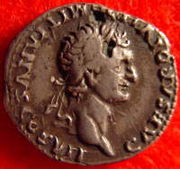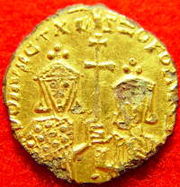
Fourrée
Encyclopedia


Coin
A coin is a piece of hard material that is standardized in weight, is produced in large quantities in order to facilitate trade, and primarily can be used as a legal tender token for commerce in the designated country, region, or territory....
, most often a counterfeit
Counterfeit
To counterfeit means to illegally imitate something. Counterfeit products are often produced with the intent to take advantage of the superior value of the imitated product...
, that is made from a base metal core that has been plated with a precious metal to look like its solid metal counter part. The term is normally applied to ancient silver plated coins such as the Roman
Ancient Rome
Ancient Rome was a thriving civilization that grew on the Italian Peninsula as early as the 8th century BC. Located along the Mediterranean Sea and centered on the city of Rome, it expanded to one of the largest empires in the ancient world....
denarius
Denarius
In the Roman currency system, the denarius was a small silver coin first minted in 211 BC. It was the most common coin produced for circulation but was slowly debased until its replacement by the antoninianus...
and Greek
Ancient Greece
Ancient Greece is a civilization belonging to a period of Greek history that lasted from the Archaic period of the 8th to 6th centuries BC to the end of antiquity. Immediately following this period was the beginning of the Early Middle Ages and the Byzantine era. Included in Ancient Greece is the...
drachma
Greek drachma
Drachma, pl. drachmas or drachmae was the currency used in Greece during several periods in its history:...
, but the term is also applied to other plated coins.
Cicero mentions that M. Marius Gratidianus
Marcus Marius Gratidianus
Marcus Marius Gratidianus was a praetor and a partisan of the popularist faction led by his uncle Gaius Marius during the Roman Republican civil wars of the 80s...
, a praetor
Praetor
Praetor was a title granted by the government of Ancient Rome to men acting in one of two official capacities: the commander of an army, usually in the field, or the named commander before mustering the army; and an elected magistratus assigned varied duties...
during the 80s BC, was widely praised for developing tests to detect false coins, and removing them from circulation. Gratidianus was killed under Sulla
Lucius Cornelius Sulla
Lucius Cornelius Sulla Felix , known commonly as Sulla, was a Roman general and statesman. He had the rare distinction of holding the office of consul twice, as well as that of dictator...
, who introduced his own anti-forgery law (lex Cornelia de falsis), that reintroduced serrated edges on precious metal coins, an anticounterfeiting measure that had been tried earlier. Serrated denarii, or serrati, which featured about 20 notched chisel marks on the edge of the coin, were produced to demonstrate the integrity of the coin. This effort was in vain, as examples of fourrée serrati attest.
Production
Production of fourrées began almost as early as the production of the first coins in Asia Minor in the 7th century BC. These coins were produced by people wishing to profit by producing a counterfeit containing less precious metal content than its purported face value. The most common method for producing a fourrée was to take a flan of copper, wrap it with silver foil, heat it, and strike it with the dies. If the coin was sufficiently heated and struck hard enough, a layer of eutecticEutectic point
A eutectic system is a mixture of chemical compounds or elements that has a single chemical composition that solidifies at a lower temperature than any other composition. This composition is known as the eutectic composition and the temperature is known as the eutectic temperature...
alloy (a mixture of 72% silver and 28% copper that has the lowest melting point of any mixture of these two metals) would be produced, fusing the layers together. Sometimes eutectic was sprinkled between the layers to increase the bond. Exposure of the deception was often due to wear at the high points of the coin, or moisture trapped between the layers that caused the foil to bubble and then break as the core corroded.
A later method for making fourrées involved adding silver to the base metal coin after it had been struck. This method allowed even less silver to be used, which became more important in order to make counterfeiting profitable as the official coinage was debased
Debasement
Debasement is the practice of lowering the value of currency. It is particularly used in connection with commodity money such as gold or silver coins...
. The exact method by which these coins were silvered is unclear, although possible methods include dipping the coin in molten silver, brushing the coins with molten silver, or dusting the coin with powdered silver and heating it until the silver melted.
In peripheral regions, even cruder counterfeits might pass: in the Viking-age site in Coppergate, Coppergate, York
Jorvik Viking Centre
The JORVIK Viking Centre is a museum and visitor attraction in York, England. It was created by the York Archaeological Trust.- Background :Cravens, a firm of confectioners founded in 1803, relocated from their factory in Coppergate, a street in central York, in 1966...
, a forgery of an Arab dirham
Dirham
Dirham or dirhem is a unit of currency in several Arab or Berber nations, and formerly the related unit of mass in the Ottoman Empire and Persian states...
was found, struck as if for Isma'il ibn Achmad (ruling at Samarkand, 903-07/8), of copper covered by a once-silvery wash of tin
Tin
Tin is a chemical element with the symbol Sn and atomic number 50. It is a main group metal in group 14 of the periodic table. Tin shows chemical similarity to both neighboring group 14 elements, germanium and lead and has two possible oxidation states, +2 and the slightly more stable +4...
.
Detection

Another method to determine whether a coin was plated was listening to the sound produced by dropping the coin onto a hard surface since if the coin was solid silver it would have a distinctive ring. Although this was done by contemporary merchants, it is not recommended that this method be used on ancient coin since the coin could be damaged, especially since over time silver coins can become brittle, if the silver begins to recrystallize.
The most obvious way to detect a plated coin would be if the base metal core was damaged or worn, revealing the base metal. There are often chisel or chop marks on ancient silver coins by merchants attempting to determine if a coin was solid. These "banker marks" are most common on Roman denarii of the 1st century BC and 1st century AD.
During the Crisis of the Third Century
Crisis of the Third Century
The Crisis of the Third Century was a period in which the Roman Empire nearly collapsed under the combined pressures of invasion, civil war, plague, and economic depression...
, constant wars required a lot of coins to be produced, leading to heavy debasing of precious metal coinage. The antoninianus
Antoninianus
The antoninianus was a coin used during the Roman Empire thought to have been valued at 2 denarii. It was initially silver, but was slowly debased to bronze. The coin was introduced by Caracalla in early 215 and was a silver coin similar to the denarius except that it was slightly larger and...
was eventually debased to the point where flans (blank metal disks) were produced with 5% silver or less, and pickled to dissolve the copper from the surface producing a spongy surface of almost pure silver. When these coins struck, the force of striking would produce a thin shiny layer of silver on the surface, which would quickly wear away. These "silvered" coins are not considered fourrées, since they are not actually plated since the metal is actually a continuous layer and these coins were not created to deceive.
Modern examples
Of modern coins, the clad US quarter dollar is an example of a coin which is not a fourrée, it is made of two layers of copper nickel, with copper sandwichSandwich
A sandwich is a food item, typically consisting of two or more slices of :bread with one or more fillings between them, or one slice of bread with a topping or toppings, commonly called an open sandwich. Sandwiches are a widely popular type of lunch food, typically taken to work or school, or...
in between and therefore is not a plated coin. The 1982 and later US one cent piece (Lincoln penny) is an example of a fourrée since it is zinc
Zinc
Zinc , or spelter , is a metallic chemical element; it has the symbol Zn and atomic number 30. It is the first element in group 12 of the periodic table. Zinc is, in some respects, chemically similar to magnesium, because its ion is of similar size and its only common oxidation state is +2...
which has been plated with copper in a manner to deceive.
Fourrée is also spelt with and without the accent (é), with one or two r's, and with one or two e's. The Latin term for a silver plated copper coin is subaeratus and the Greek name is hypochalkos, both meaning "copper below".

